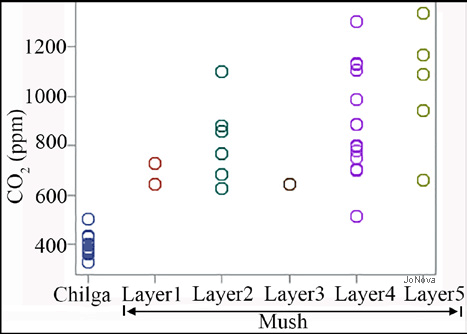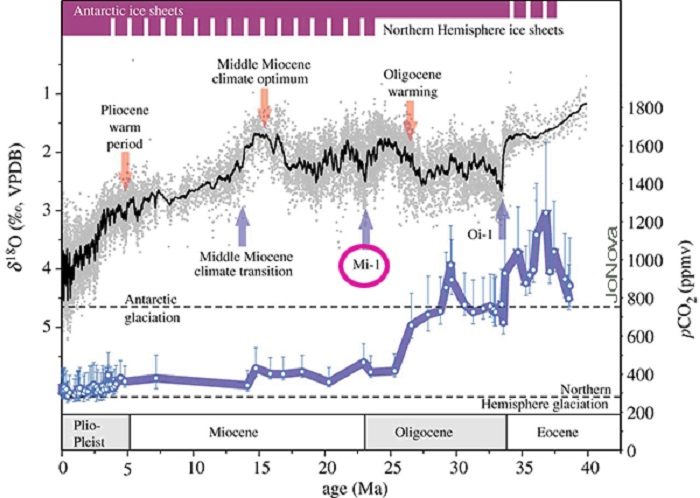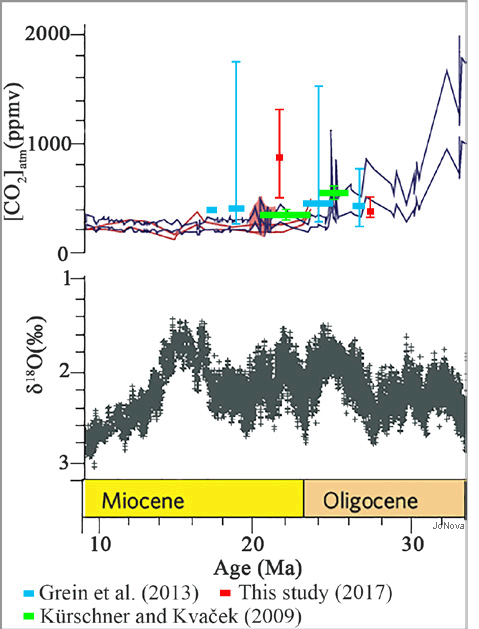Nov 16, 2017: Scientists Solve 22 Million-Year-Old Climate Puzzle -"Paleoclimate Events Can Predict Earth's Future"
Solved yesterday, settled today! That's a rapid fire consensus... (they actually use the word "settled" in the title of the paper)
Study Settles prehistoric puzzle, confirms modern link of carbon dioxide and global warming
Finally poor Miocene researchers can sigh with relief as the first study in years shows what they *knew* was the right answer and now they can issue press releases, rest their weary minds, and stop trying to think of excuses as to why their results didn't fit with The Climate Model Testaments.
Who knew there were large discrepancies and carbon dioxide did not fit the temperature theory for a million years or so? Not the public.
Where were the press releases?
Research Shows A High Temperature World Had Nothing To Do With CO2
Study shows temperatures fell dramatically, CO2 stayed the same
Study shows models have no freaking clue what controls the climate
Exactly, never.
The mystery they are talking about is the one marked Mi-1, 22 million years ago. This graph ( see image above) comes from Zachos 2008, a graph that is vying to become my new hot favorite since it has 40 million years of non-stop paradigm-busting mysteries. Watch CO2 control the climate while it stays steady for twenty million years and temperatures fall, rise, fall, spike, crash and slump into the modern Ages of Ice. This kind of climate sensitivity defies numerical analysis. If CO2 controls the climate with this kind of fickle unpredictability, it is more of a God than just a molecule, and we don't need carbon reduction - we need places of worship. Maybe human sacrifices.
Years ago in my ninth ever post I pointed out that sometimes the only place that Experts admit that their results were ballsed up and the models didn't work was in the introduction of a paper where they think they've solved it. So it was with the missing Hot Spot which people never said was missing except in a paper where they had just found it.
Here we find periods where the carbon theory fails, but are not called failures or mysteries (until after they are solved) instead they are known as periods of decoupling:
Furthermore, we aim to address the question of decoupling between atmospheric [CO2]atm and global temperature change during this time interval, particularly evident in the marine realm (Pagani et al., 2005; Henderiks and Pagani, 2007; Plancq et al., 2012), a question that clearly has profound implications for 21st-century climates.In the normal world CO2 either controls the climate or it doesn't. In the climate religion, CO2 either controls the climate or it is decoupled. There is no option for "does not control the climate".
Here's the graph from the new paper where a new variation on modeling of stromatal leaf changes. This time (joy) the CO2 rises from ~390 ppm in the late Oligocene to ~870 ppm at the "right" time. Did it lead the temperature spike or follow it? Yes. Definitely one or the other.
Assuming they are right this time, all they have achieved in the climate debate is just to stop the models being proved wrong at that point. The thing that matters is whether CO2 rose before temperature or after it, and since we can't find clear signals about that in 2017, it's no surprise that we can't figure that out in 22 million BC either. I note table 1 says that the CO2 readings at Mush Valley are 21.73 Million years ± 30,000 years. In modern equivalent terms it's like we are assessing the whole global climate and CO2 levels since the Neanderthals with one dot on a graph.
The climate religion is evident throughout this paper: (the paper is more use as a sociological study)
Although the absolute amount of global temperature change between the late Oligocene and early Miocene is not known precisely, warming was likely on the same order of magnitude (~2 °C) as expected for the 21st century (Hansen et al., 2013; IPCC, 2014), and the expectation is that it was associated with an increase in atmospheric [CO2]atm. Nevertheless, previous studies documenting [CO2]atm for the cooler part of the late Oligocene and the relatively warmer early Miocene provide inconsistent and often counterintuitive results, possibly due to the use of different proxies or imprecisely dated strata.Another word for failure is counterintuitive.
Below: that's quite a lot of spread in those new happy CO2 results at the place called Mush (Fig 3 below). I see CO2 levels of 800ppm, 1200ppm. Isn't that disastrous? Did we miss that mass extinction?

atm mean values; complete results for each individual specimen are given in the Data Repository
(Table DR3). Late Oligocene [CO2]atm estimates range from 330 to 500 ppm, with a grand
mean of ~390 ppm, and early Miocene [CO2]atm estimates range from ~510 to 1340 ppm, with a grand mean of ~870 ppm (Table 1).
(And since when was Mush, Ethiopia, representative of The World anyway?
For background, and if you like watching scientists tap dance around their gremlins, this paper by Zhang in 2013 explains more about the significance of the Miocene Mysteries:
A 40-million-year history of atmospheric CO2Which all explains why we haven't heard much about the Miocene in the climate propaganda in the last twenty years.
Yi Ge Zhang, Mark Pagani, Zhonghui Liu, Steven M. Bohaty, Robert DeConto
Published 16 September 2013.DOI: 10.1098/rsta.2013.0096
The Miocene Epoch (23 - 5 million years ago) is one of the most enigmatic times of the recent history of the Earth's climate. The middle Miocene climatic optimum is one of the warmest intervals of the current icehouse period, being the culmination of several million years of warming from the beginning of the Miocene (Figure 1). Evidence suggests that the climate fundamentally changed during the middle Miocene transition, particularly on East Antarctica where a much reduced ice sheet with a vegetated landscape changed to a cold polar climate, potentially with ice sheets as large as today (Sandroni and Talarico, 2011).
Another apparent decoupling between CO2 and climate occurs near the Oligocene-Miocene boundary (approx. 23 Ma), represented by a transient, positive benthic foraminiferal δ18O excursion (greater than 1‰) interpreted as a period of substantial glaciation (known as the Mi-1 event) [76]. Our records suggest invariant CO2 concentrations during this apparent glaciation/deglaciation, defying our current understanding of the necessary forcing required to drive Antarctic ice sheet variability.
Assuming approximately 2°C of cooling in the deep sea [77], approximately 0.5‰ of the 1‰ δ18O shift at Mi-1 must have been driven by an increase in ice volume. If continental ice on Antarctica had an average isotopic composition of −40‰, as indicated by isotopic modelling [71], then more than 22×106 km3 of ice-roughly equivalent to the entire present-day East Antarctic Ice Sheet (EAIS)-must have accumulated within 400 000 years. However, CO2 levels during the Oligocene appear low enough to have already maintained a fully glaciated Antarctica according to ice sheet simulations [78]. Moreover, the recovery phase of Mi-1 is even more enigmatic because models require substantially higher CO2 levels-at least two times higher than the formation threshold of the EAIS (approx. 1500 ppm) to cause substantial ice sheet retreat [71,78].
H/t Lance W Thank you.
References:
Tesfamichael et al (2017) Settling the issue of "decoupling" between atmospheric carbon dioxide and global temperature: [CO2]atm reconstructions across the warming Paleogene-Neogene divide, Geology, November 2017; v. 45; no. 11; p. 999-1002 | Data Repository item 2017337 | doi:10.1130/G39048.1 |
Kürschner et al., 2007. The impact of Miocene atmospheric carbon dioxide fluctuations on climate and the evolution of terrestrial ecosystems. PNAS, 105: 449-453.
LaRiviere et al., 2012. Late Miocene decoupling of oceanic warmth and atmospheric carbon dioxide forcing. Nature, 486: 97-100.
Pagani et al., 2005. Marked decline in atmospheric carbon dioxide concentrations during the Paleogene. Science, 309: 600-603.
Zachos et al., 2001. Trends, rhythms and aberrations in global climate 65 Ma to present. Science, 292: 686-693.
Zachos JC, Dickens GR, Zeebe RE. 2008 An Early Cenozoic perspective on greenhouse warming and carbon-cycle dynamics. Nature 451, 279-283. (doi:10.1038/nature06588)





Reader Comments
I have also worked on ERVs (energy recovery ventilators) for both auditoriums and indoor stadiums. when ya get a lot of folks in a confined space... co2 can build up rapidly.. humans emit co2 as a part of their respiratory system. and since co2 is heavier than air... it sinks. (and that is where the people are...) it does not float in undisturbed air.
Not a moment to waste. Clinton and Gore will back us.